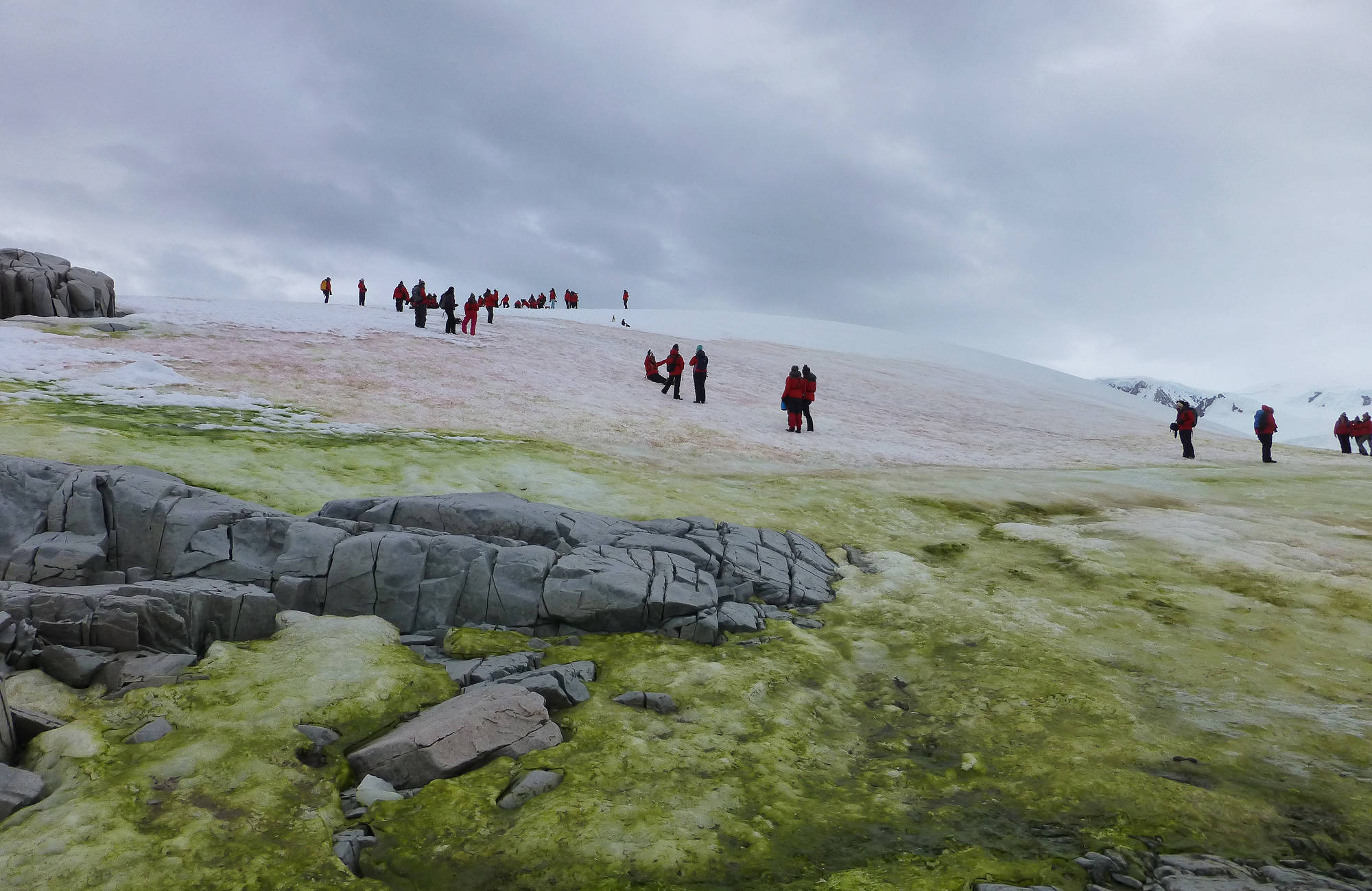As we stepped out of zodiacs and landed on Pleneau Island off the west coast of the Antarctic Peninsula, we saw green. In an environment of ice, snow and barren rock, green is notable. We had seen pink snow at some of our earlier landings. Penguins eat a lot of krill, which are shrimp-like crustaceans with pink pigmentation. What goes in must come out. We assumed that when penguins poop, they pooped pink. But green poop?
As a team of 76 scientists, our inquiring minds wanted answers. Although we were on an expedition ship, we did not have research permits to deploy probes and nets over the side or collect water samples for analysis back home.
However, one brilliant researcher had thought ahead. Hannah, a PhD student from the University of Cambridge in the United Kingdom, packed a small microscope in among her extra socks, hats and gloves. When we hit Pleneau Island, she whipped out her portable WaterScope to exclamations of surprise and jealousy, and took a closer look at the pink- and green-tinged snow on the spot.
What she saw and shared with all of us was red and green cells of algae. It turns out that although some of the pigment we saw on the snow was coming from the penguins’ krill-based diet, there were also algae turning the snow pink and green. We see this here in Alaska at times. When the sun heats up the snow surface on a glacier or snowfield, certain algae can thrive in the water on the snow surface. In Antarctica, these colors and evidence of available nutrients for algae to grow on snow was surprising.
Our warming world is exposing more and more barren edges as ice shelves collapse and glaciers retreat; melting snow is more common as temperatures rise in the polar regions. Can these newly emerging edges transform into productive, life supporting ecosystems? For this to happen, nutrients need to be transported from the highly productive oceans onto the new landscape.
A snow-free, postglacial beach strewn with pebbles for making nests is paradise to a pair of breeding Gentoo penguins. With hordes of tottering birds going off to the ocean daily to catch krill and returning to land to feed little chicks, penguin poop in volume and stench is impressive. Based on a rough estimate, a colony of 500 Gentoo penguins would result in 3,000 pounds of poop each year. This rich contribution of marine-derived nutrients will slowly transform these rockscapes into coastal ribbons of algae and carpets of moss.
Here in Alaska, salmon are the conduits for moving ocean nutrients into coastal systems. Spawning salmon feed the bears and eagles and contribute to the overall productivity of the landscape. As receding glaciers create new freshwater habitat, straying salmon will soon follow. Over time marine-derived nutrients will build up enough to support algal growth and aquatic insects. Dead salmon can bring a newly emerging stream to life.
Although new habitat for penguins and salmon seems like all good news, the reality is that recent warming is happening fast and ecosystem interactions are complex. New, snow-free habitat for Gentoo penguins likely means fewer colonies of sea ice-dependent Adélie penguins. And for salmon, the same warming that melts the glaciers to create new habitat also warms the ocean and streams, which makes them vulnerable to pollution, predation and disease. The dismal returns of Chinook salmon to Cook Inlet this year may be the result of warmer water in the Gulf of Alaska.
And even the story of green and pink snow and algae flourishing from penguin poop has a darker side. One of the key drivers of melting snow and ice is a decrease in albedo in polar regions. A white, ice-covered surface reflects solar radiation (high albedo) while darker surfaces absorb more solar radiation (low albedo). Snow algae, which grows when there is a little bit of melting snow, darkens the snow surface and accelerates the snow melting. A recent study estimated that there is a 13 percent decrease in snow albedo by red pigmented snow algal blooms over the course of one melt season in the Arctic. A study on the Kenai Peninsula’s Harding Ice Field showed red-snow algae increased melting by about 17 percent. This new understanding of the role of snow algae in accelerating melt rates has yet to be built into climate models.
From Antarctica to Alaska, a shift of just a few degrees can alter the color of the landscape. For me, seeing the algae under Hannah’s scope was more clear evidence that species are responding in significant ways to our changing climate. Time will tell if keystone species like penguins and salmon, which are critical links between the marine and land ecosystems, can adapt quickly enough. Perhaps more importantly is whether we will be able to adapt our economic and political systems fast enough to slow down the warming and give them a fighting chance.
Sue Mauger is Science Director for Cook Inletkeeper and lives in Homer. She went to Antarctica as part of Homeward Bound — a global leadership initiative for women in science.

